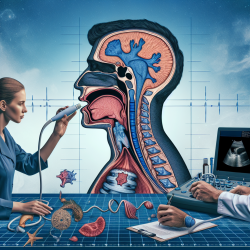Unlock the Secret to Improving Swallowing Assessments with Ultrasound!
As a practitioner in the field of speech and language pathology, you are always on the lookout for innovative tools and techniques to enhance your practice. One such emerging tool is ultrasound (US), which is increasingly being recognized for its potential in assessing swallowing and laryngeal function. The recent study, "Translating Ultrasound into Clinical Practice for the Assessment of Swallowing and Laryngeal Function: A Speech and Language Pathology-Led Consensus Study," provides a comprehensive framework for integrating US into clinical practice.
Why Ultrasound?
Ultrasound offers several advantages for assessing swallowing and laryngeal function:
- Accessibility and portability
- No radiation exposure
- Non-invasive and suitable for repeated examinations
- Technological advancements improving image quality
These features make US an attractive option for prolonged or repeat examinations, especially in hard-to-reach patient groups.
Key Outcomes from the Study
The study utilized the Nominal Group Technique (NGT) to establish consensus on the priorities for translating US into clinical practice. Here are some key outcomes:
1. Establishing Reliability and Validity
Reliability and validity emerged as top priorities. Ensuring that US measurements are consistent and accurate is crucial for effective clinical use.
2. Developing Normative Data
Creating a database of 'normal' values for swallowing and laryngeal function will help practitioners identify deviations indicative of disorders.
3. Training Protocols
Developing comprehensive training protocols is essential for practitioners to effectively use US in their assessments.
4. Stakeholder Engagement
Engaging with stakeholders, including professional bodies and multidisciplinary teams, is vital for the successful implementation of US in practice.
Implementing Ultrasound in Your Practice
To implement US effectively, consider the following steps:
- Participate in training programs to build competency in US technology and interpretation.
- Engage with stakeholders to secure resources and support for US integration.
- Stay updated with ongoing research and advancements in US technology.
By following these steps, you can enhance your practice and provide better care for your patients.
Encouraging Further Research
The study highlights the need for ongoing research to address gaps in evidence and refine US applications in clinical settings. As a practitioner, you can contribute to this body of knowledge by participating in research initiatives and sharing your experiences with US in practice.
To read the original research paper, please follow this link: Translating Ultrasound into Clinical Practice for the Assessment of Swallowing and Laryngeal Function: A Speech and Language Pathology-Led Consensus Study.










